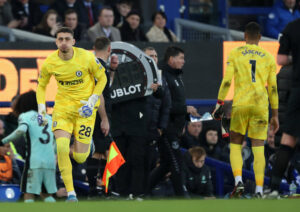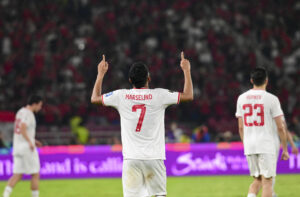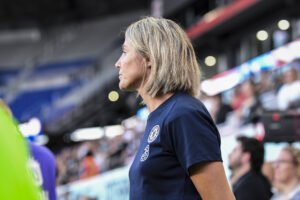This weekend sees the first ever league meeting of MK Dons and A.F.C. Wimbledon. The two clubs were born out of the ashes of the now defunct Wimbledon Football Club. Most people know the story of how the original Dons rose from non-league football to F.A. Cup winners in just over ten years. Very little seems to have been written, however, about Wimbledon’s Premier League Years. They were one of the founding members of the division in 1992, and while they may be gone, they shouldn’t be forgotten.
Many fans of other clubs seemed to look down on Wimbledon during their time in the Premier League. It may be because they had risen from Non-League and, as such, didn’t have the trophy-laden history of other clubs in the division. There is also the fact that they did not have their own stadium. It has to be said, however, that for most of Wimbledon’s Premier League years, they were one of the trickiest away fixtures.
They often threw a spanner in the works of many teams battling for honours. They achieved all of this in spite of the fact that, to balance their books, they regularly sold their best players each year.
Background
Wimbledon’s rise to the top flight of English football, was a remarkable story. They were elected to the old Division Four in 1977, after winning the Southern League three times in succession. By 1986 they had won promotion to Division One. At first they bounced between the third and fourth divisions, and during this time they were managed by Allen Batsford, and then Dario Gradi. It was when Gradi’s assistant manager Dave Bassett took charge, however, that the club became known as the “Crazy Gang”.
Playing a long ball style of football, players such as John Fashanu, Vinnie Jones and Dennis Wise were known for intimidating opponents. It may not have been pretty, but it worked. Nobody looked forward to this particular away fixture. This was not the only reason for their famous nickname, however. Their eccentric owner Sam Hamman, the reports of practical jokes and outrageous initiation ceremonies for new players were all contributing factors.
When Bassett departed for Watford in 1987, Bobby Gould was appointed as manager. He brought in former Arsenal manager Don Howe as his assistant, and the two made an instant impression on the players. In Gould’s first season, Wimbledon shocked the world by beating champions Liverpool 1-0 Wembley to lift the F.A. Cup.
Many tipped Wimbledon to be instantly relegated after their promotion to Division One, but they finished 6th in their first season in the top flight. In the seasons that followed, they regularly achieved top ten finishes, and never once battled relegation. The only downside was that Plough Lane was deemed incapable of being redeveloped to meet the all-seater stadia criteria, which was mandatory following the famous Taylor Report. The ground closed for good in 1991. By the time the Premier League was formed in 1992, Wimbledon were sharing Selhurst Park with Crystal Palace.
1992-93
Wimbledon’s first Premier League fixture was against Leeds United at Elland Road, which they lost 2-1. Their first ever goal in the division was scored by defender Warren Barton. Some of the team who had lifted the F.A. Cup were still with the club, such as Lawrie Sanchez, John Fashanu, and John Scales. There were plenty who had long since departed, however, such as Dennis Wise (to Chelsea), Dave Beasant, (Newcastle United) and Eric Young (Crystal Palace). Vinnie Jones had left for Leeds United, but returned to the club after spells with Sheffield United and Chelsea. Terry Phelan joined Manchester City at the start of the campaign.
The season was an unremarkable one in terms of their league position, finishing in 12th place under Joe Kinnear. They did beat eventual champions Manchester United at Old Trafford in October, and also dented the title hopes of Norwich City, beating them 3-0 in March. Another ray of light for the fans was the form of Dean Holdsworth. The striker, signed from Brentford in the summer of 1992, scored 19 Premier League goals in his first season with the club.
1993-94
Wimbledon managed their highest ever Premier League place, finishing 6th in the table in 1993-94. Holdsworth was once again in impressive form, netting 24 goals in all competitions. His exploits fuelled speculation that he would be the next big name departure, with Manchester United rumoured to be interested.
The Dons once again had their say in the title race, beating both United and Blackburn Rovers towards the end of the campaign. This would also be club legend John Fashanu’s final season with the club, as he transferred to Aston Villa the following summer. Although the fans were disappointed with his sale, this was the most impressive of Wimbledon’s Premier League Years.
The campaign was overshadowed, however, by two of their players being investigated for alleged match fixing. Fashanu, along with goalkeeper Hans Segers and Liverpool legend Bruce Grobbelaar. All three were eventually cleared by the courts, but later found guilty of breaching F.A regulations
1994-95
The club once again placed in the Premier League’s top ten, recording a 9th place finish after another steady campaign. They were also involved in some high scoring matches. They recorded two 4-3 victories, at home to Aston Villa and away to Leicester City. Villa got their revenge in February, however, beating the Dons 7-1.
Having already lost Fashanu over the summer, the club lost another long serving star in defender John Scales. He joined Liverpool in a £3.5 million transfer in September 1994. The fans soon had a new hero, however, in the form of Norwegian midfielder Øyvind Leonhardsen. He had joined the club from Rosenborg, and quickly became a key player. This season saw Holdsworth’s form take a dip, and new signing Efan Ekoku was the club’s top scorer with nine goals.
1995-96
Another year, another set of big name departures. Right back Warren Barton joined Newcastle United for £4 million in the close season, and goalkeeper Hans Segers joined Wolverhampton Wanderers. Club legend Andy Thorn, part of the F.A. Cup winning side, also departed at the end of his second spell at the club.
This was the one and only time in their history that Wimbledon competed in any European competition. Having missed out in 1988 due to the ban on English clubs in Europe, they entered the Intertoto Cup. With Selhurst park unavailable, their home games were played at Brighton’s Goldstone Ground. The distance saw a lack of interest from the fans, and Wimbledon were eliminated after finishing fourth in their group.
The club recorded their lowest Premier League finish at that point, ending the season in 14th place. This was helped in no small part by a run of almost three months without a league win, and seven straight defeats. Despite high scoring performances from Robbie Earle (11) and Dean Holdsworth (16), they finished three points above the relegation zone.
1996-97
Wimbledon were involved in one of the biggest headlines of the season on the opening day. David Beckham’s goal from the halfway line catapulted him to worldwide fame when it flew over Wimbledon goalkeeper Neil Sullivan. The Dons recovered from this, however, and went on to enjoy a good season. On the way to finishing in 8th place, they beat Liverpool 2-1 at Selhurst Park to end their title hopes. The club also reached the semi-finals of both the League and F.A. cups. They were eliminated by the eventual winners, Leicester City and Chelsea respectively.
The form of Øyvind Leonhardsen had improved year after year, and this would be his last season at the club. In the summer of 1997, Liverpool paid Wimbledon £3.5 million to take him to Anfield. Filling his shoes would not be easy.
1997-98
Wimbledon had an impressive start to the season, but their form dipped dramatically in the New Year, and they finished in 15th place. A contributing factor to this was the lack of goals, with Jason Euell their top scorer with eight in total. Only four of these came in the Premier League.
If the team hadn’t been depleted enough by the sale of Leonhardsen, Wimbledon lost some more big characters during the season. The last remaining member of the old Crazy Gang, Vinnie Jones, left to join Queens Park Rangers in March 1998. Earlier in the season, Dean Holdsworth had joined Bolton Wanderers, which didn’t help their “goals for” column. The 1997-98 season seemed to mark the beginning of the club’s decline.
1998-99
Once again, Wimbledon began the season in good form. A 3-1 home win over Tottenham Hotspur on the opening day of the season seemed to breed confidence within the squad. By the end of 1998, they had beaten Arsenal, Liverpool and West Ham United, which had the fans dreaming of a European place. They had also reached the semi-finals of the League Cup, and things seemed to be looking rosy.
In January 1999, the Dons paid a club record £7.5 million for West Ham striker John Hartson. The Welshman seemed to be exactly what Wimbledon needed to make that European dream a reality. Unfortunately, what happened was that Hartson scored just two goals before the end of the season. Furthermore, the club won just one more league game, and lost nine of their last eleven. They finished in 16th place, just six points above the drop zone. Had they not had such an impressive start to the campaign, the inevitable relegation would have happened a year earlier.
1999-200
This was the season when the remarkable tale of Wimbledon’s Premier League years came to an end. Joe Kinnear had resigned due to health issues during the summer, and replaced by Norwegian Egil Olsen. Defender Chris Perry was the most notable departure, joining Tottenham for £4 million. Other long serving players such as Andy Clarke, Peter Fear and Efan Ekoku had also left. Olsen replaced them with several Scandinavian imports such as Hermann Hreiðarsson, Andreas Lund and Trond Anderson.
Carl Cort and John Hartson were the clubs main strikers, both scoring nine Premier League goals apiece. In spite of this, the new look side never gelled, winning just seven league games. Olsen was sacked with two games remaining before the end of the campaign.
Going into the final day of the season, the Dons still had a chance of beating the drop. They were level on points with Bradford City, and needed to better the Bantams’ result to stay up. Bradford managed to beat Liverpool 1-0, whereas Wimbledon lost 2-0 at Southampton. On May 14th 2000, exactly twelve years to the day that they lifted the F.A. Cup, Wimbledon were relegated from the Premier League. The dream was over.
Aftermath
Wimbledon dropped into Division One (now known as the Championship), and it all went downhill from there. In the summer of 2002, the club were granted permission by the football league to relocate to Milton Keynes. This generated anger amongst many long-time Wimbledon fans, and a breakaway club, A.F.C Wimbledon, was formed.
In 2003, Wimbledon entered administration, which resulted in many of the clubs’ players being sold. As a result the club finished bottom of Division One. At the end of the 2003-04 season, the club was bought out and renamed Milton Keynes Dons. The club has thrived since it’s rebranding, but has never threatened to reach the heights of its predecessor. They now find themselves in the same division as A.F.C Wimbledon, League One. The two clubs will contest their first ever league fixture on Saturday.
Final Thought
It’s hard to imagine there ever being another team whose story quite matches that of Wimbledon Football Club. A side who could always be counted upon to cause an upset, especially against teams who took victory against them for granted. There is no doubt that one of the main reasons for all of their successes was their incredible team spirit. They were not afraid of anyone and in 1988, with the whole world watching, they proved it at Wembley.
Anyone who followed football in the 1990’s will remember Wimbledon’s Premier League years with great affection. Despite the differences between the fans of MK Dons and A.F.C. Wimbledon, both were born from the ashes of the Crazy Gang. Their achievements should never be forgotten.
Main Photo






